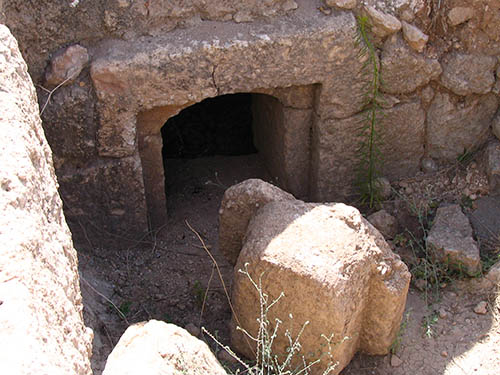Examining the tomb of Jesus in light of Second Temple-period Jerusalem tombs
“Early on the first day of the week, while it was still dark, Mary Magdalene came to the tomb and saw that the stone had been removed from the tomb.”—John 20:1, NRSV
What kind of stone sealed the tomb of Jesus? Was it a round (disk-shaped) stone or a square (cork-shaped) stone? While both kinds of blocking stones are attested in Jerusalem tombs from the time of Jesus, square (cork-shaped) stones are much, much more common than round (disk-shaped) ones.


How was Jesus’ tomb sealed? While some Jerusalem tombs from the late Second Temple period boasted round (disk-shaped) rolling stones, it was more common to seal tombs with cork-shaped stones, such as the one pictured here. The archaeological evidence suggests that the tomb of Jesus—the unused tomb of Joseph of Arimathea—would have been sealed with a cork-shaped stone. Photo: Tom Powers.
In fact, of the more than 900 Second Temple-period burial caves around Jerusalem examined by archaeologist Amos Kloner, only four have been discovered with disk-shaped blocking stones. These four elegant Jerusalem tombs belonged to the wealthiest—even royal—families, such as the tomb of Queen Helena of Adiabene.
Become a Member of Biblical Archaeology Society Now and Get More Than Half Off the Regular Price of the All-Access Pass!
Explore the world’s most intriguing Biblical scholarship
Dig into more than 9,000 articles in the Biblical Archaeology Society’s vast library plus much more with an All-Access pass.
Was the tomb of Jesus among the “top four” Jerusalem tombs from the Second Temple period?
Since disk-shaped blocking stones were so rare and since Jesus’ tomb was built for an ordinary person—because it was actually the borrowed, but unused, tomb of Joseph of Arimathea (Matthew 27:60)—it seems highly unlikely that it would have been outfitted with a disk-shaped blocking stone.
Archaeology therefore suggests that the tomb of Jesus would have had a cork-shaped blocking stone. Is this confirmed or contested by the Biblical text? How was Jesus’ tomb sealed according to the New Testament?
In his Biblical Views column “A Rolling Stone That Was Hard to Roll” from the March/April 2015 issue of BAR, Urban C. von Wahlde looks at the Gospel accounts to see how the stone that sealed the tomb of Jesus is portrayed. His careful analysis of the Greek grammar reveals a detail from the Gospel of John that supports the idea that the tomb of Jesus was indeed sealed with a cork-shaped stone.


In his BAR column, Urban C. von Wahlde explains that the Synoptic Gospels (Matthew, Mark and Luke) all use a form of the Greek verb kulio to describe how the stone sealing Jesus’ tomb was moved. Kulio means “to roll.”


Measuring 4.5-feet tall, the disk-shaped stone at the so-called Tomb of Herod’s Family could be rolled to cover the entryway of the tomb or rolled back into a niche to open it, thereby permitting new burials to be added to the family tomb. This is one of four Second Temple-period Jerusalem tombs with a round rolling stone. Photo: Hershel Shanks.
Mark 15:46 reads, “Then Joseph bought a linen cloth, and taking down the body, wrapped it in the linen cloth, and laid it in a tomb that had been hewn out of the rock. He then rolled a stone against the door of the tomb” (NRSV). The Greek verb used in the last sentence of this passage is proskulisas. Von Wahlde says, “This is a combination of pros (meaning ‘toward’) and the past participle of kulio (meaning ‘to roll or roll along’).”
Mark 16:3 describes the scene on Easter Sunday when Mary Magdalene, Mary the mother of James and Salome visit Jesus’ tomb: “They had been saying to one another, ‘Who will roll away the stone for us from the entrance to the tomb?’” The Greek word for “roll away” is apekulisen, which von Wahlde explains is “a combination of ap’ (meaning ‘away’) and … yes, kulio (meaning ‘to roll’).”
The Gospels of Matthew and Luke use similar compounds of the verb kulio. Thus, all of these accounts imply that the stone sealing Jesus’ tomb was rolled.
Can square (cork-shaped) blocking stones be rolled?
In his article “Did a Rolling Stone Close Jesus’ Tomb?” from the September/October 1999 issue of BAR, Amos Kloner added “dislodge” or “move” to the definition of the Greek verb kulio. A square (cork-shaped) blocking stone might more readily be described as being “dislodged” or “moved” than “rolled.” Thus, this definition resolves any incongruity between the Biblical text and the archaeological record. However, von Wahlde disagrees with Kloner’s definition:
In his article on the type of tomb closure used for the tomb of Jesus, Amos Kloner states that the Greek verb kulio means “to roll,” but it can also mean “dislodge” or “move.” I would disagree with this for two reasons: First, I at least cannot find any dictionary articles (including the largest, the Liddle-Scott-Jones) that give this other meaning. Second, as I pointed out above, almost all instances of the verb in the gospel texts are compounds of kulio, either pros-kulio (“roll up to”) or apo-kulio (“to roll away”). These are verbs of motion “toward” or “away from.”
It is not necessary to change the definition of kulio to make sense of the Gospel accounts. Von Wahlde points out: “It may very well be that people rolled the ‘cork-shaped’ stones away from the tomb. Once you see the size of a ‘stopper’ stone, it is easy to see that, however one gets the stone out of the doorway, chances are you are going to roll it the rest of the way.” Although they certainly would not have rolled as easily as round (disk-shaped) stones, cork-shaped stones still could have been rolled.
Many assume that Jesus’ Last Supper was a Seder, the ritual Passover meal. Examine evidence from the Synoptic Gospels with scholar Jonathan Klawans in “Was Jesus’ Last Supper a Seder?”
The Gospel of John presents a slightly different picture than the other Gospel accounts—with a different Greek verb used to describe the stone sealing Jesus’ tomb. John 20:1 reads, “Early on the first day of the week, while it was still dark, Mary Magdalene came to the tomb and saw that the stone had been removed from the tomb.”
The Greek word for “removed” or “taken away” is hairo, which Von Wahlde defines as “take away.” There is no mention of “rolling” the stone in the Gospel of John. Von Wahlde maintains that this description reflects “the Jewish burial practice much more accurately than any of the other gospels. He [John] has given us a detail none of the other gospels have.”
Thus, both the Gospel of John and archaeology support the interpretation that the tomb of Jesus would have been sealed with a cork-shaped blocking stone. For Urban C. von Wahlde’s full analysis of the type of stone that sealed Jesus’ tomb according to the Gospels, read his Biblical Views column “A Rolling Stone That Was Hard to Roll” in the March/April 2015 issue of BAR.
Later, during the late Roman and Byzantine periods, round (disk-shaped) blocking stones became less rare. Dozens of Jerusalem tombs dating to these periods have been found with disk-shaped stones—but on a smaller scale. Whereas the four disk-shaped blocking stones from the Second Temple period were at least 4 feet in diameter, the ones from later periods usually had a diameter of about 3 feet. The date and style of these tombs, however, disqualifies them as candidates for Jesus’ tomb since the tomb of Jesus belonged to an earlier period—the Second Temple period, which ended in 70 A.D. with the Roman destruction of Jerusalem.
——————Subscribers: Read the full Biblical Views column “A Rolling Stone That Was Hard to Roll,” by Urban C. von Wahlde in the March/April 2015 issue of Biblical Archaeology Review.
Not a subscriber yet? Join today.
Is it possible to identify the first-century man named Jesus behind the many stories and traditions about him that developed over 2,000 years in the Gospels and church teachings? Visit the Jesus/Historical Jesus study page to read free articles on Jesus in Bible History Daily.
Read more articles about the tomb of Jesus and other Jerusalem tombs in the BAS Library:
Amos Kloner, “Did a Rolling Stone Close Jesus’ Tomb?” BAR, September/October 1999.
Jodi Magness, “What Did Jesus’ Tomb Look Like?” BAR, January/February 2006.
R. Steven Notley and Jeffrey P. Garcia, “Queen Helena’s Jerusalem Palace—In a Parking Lot?” BAR, May/June 2014.
Ehud Netzer, “Herod’s Family Tomb in Jerusalem,” BAR, May/June 1983.
Not a subscriber yet? Join today.
This Bible History Daily feature was originally published on March 9, 2015.


